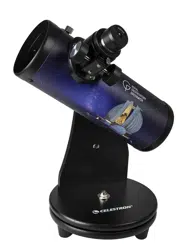Loading ...
Loading ...
Loading ...

14 | ENGLISH
Double Stars
Double stars, or pairs of stars that appear close together in the sky, are rewarding objects to observe. In some cases,
these stars are so close together that they appear to the unaided eye as single stars, but under the magnification of a
telescope, they resolve into a very closely separated pair. Some of these pairs show a very striking difference in color
between the stars. The great thing about double stars is that they are not as affected by light pollution as other deep-sky
objects are.
Some double stars will require higher magnifications to cleanly separate the two component stars. Astronomers use
special eyepieces with measuring reticles to measure the separation and angle of the two stars. Repeated measurements
of the stars’ angles over long periods of time show how fast the stars orbit each other.
Star atlases, astronomy programs, and mobile apps will identify double stars using a different symbol than single stars.
Use the starhopping method described above to locate these gems of the sky. Here are a few examples of easy to find
double stars to get you started.
Observing Albireo
Albireo is one of the most beautiful examples of a double star and, lucky for us, it is very easy to locate. Albireo appears to
the naked eye as a single star in the easily recognizable constellation Cygnus the Swan and marks the nose of the celestial
bird. What is striking about this double star is the color, a bright yellow star paired with a dimmer blue companion star.
This pair has a separation of about 1/1000th of a degree.
Observing Mizar
Mizar is a very easy double star to find, as it is located in the Big Dipper, in the constellation Ursa Major. It is the second
star from the end of the handle. Arabic texts suggest that this double star was used as a test of eyesight, as some people
can see both component stars without optical aid. They are separated by 1/5th of a degree. The fainter companion star
has its own name, Alcor.
Observing Gamma Leonis (Algieba)
Gamma Leonis, also known by the Arabic name Algieba. It is located in the easily recognizable constellation of Leo the
Lion, in an asterism called the Sickle of Leo. This group of stars, representing the lion’s mane, resembles a backwards
question mark with Regulus, the brightest star in the constellation Leo, at the very bottom. Algieba is a very close double
star. The most striking feature of this pair is the color differences, with one star being an orange-red and the other being
a greenish-yellow. In 2009, astronomers discovered that the primary star in this system, Gamma Leonis 1, has a planetary
companion that is almost 9 times more massive than Jupiter. Further data suggests that there may be a second planet
orbiting this star with a mass twice that of Jupiter, but further investigation is needed.
PRACTICE WHAT YOU HAVE LEARNED: OBSERVING DOUBLE STARS
Loading ...
Loading ...
Loading ...
